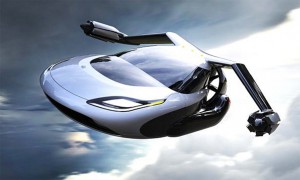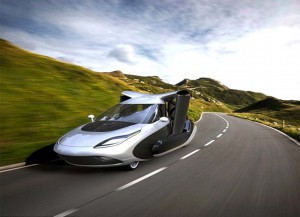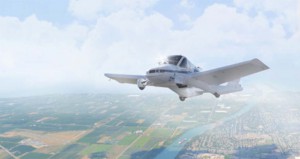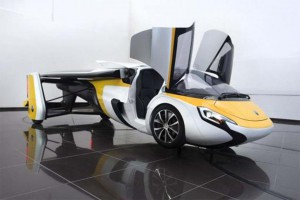
Looking like the flying car in "Back to the Future," a rendering shows the Terrafugia Transition in flight.
The long-held dream of building a flying car may be coming a big step closer to reality now that Geely, the deep-pocket parent of Volvo Cars has acquired Terrafugia, a start-up launched by a group of MIT alum.
Among an assortment of companies hoping to build flying cars, Terrafugia is one of the furthest along, with the Massachusetts-based firm already going airborne with prototype designs. More importantly, the Terrafugia Transition last year won a critical certification from the Federal Aviation Administration that would make it easier for owners to take to the air.
Funding from Zhejiang Geely could be what’s needed to push Terrafugia over the top, especially as it now faces a range of competitors hoping to take off with their own flying car and flying taxi concepts. That includes Slovakian start-up AeroMobil and Germany’s Lilium, as well as aerospace giant Airbus. Even Uber wants to get into the act, the car-sharing service recently announcing plans to take its operation airborne with a concept it has dubbed Uber Elevate.
“Don’t think of it as a car that flies. Think of it as a plane that drives,” Carl Dietrich, the CEO of the Massachusetts-based firm and one of five former MIT graduate students who came up with the idea behind the Terrafugia Transition, told TheDetroitBureau.com when the concept made its debut at the New York Auto Show in April 2012.
(Has the era of the flying car finally arrived. Click Here for more.)
An early prototype, the TF-X, looked much like a private propeller-driven airplane with fold-up wings. The latest version of the Transition has a more sci-fi appearance, reminding some of the flying Delorean from the film, “Back to the Future.” The stubby, seagull-shaped wings fold out of the body, the propeller on the twin Rotax aircraft engine opening up like the wire frame of an umbrella.
The craft does not need a conventional runway for takeoff, instead taking off vertically, the engines then rotating forward for cruising. That shift from Vertical Take-off and Landing – or VTOL – to conventional fixed-wing aircraft gave root to the craft’s name, Transition.
Terrafugia officials have suggested that could get a prototype of the Transition flying by 2019, with the production model on sale by the middle of the next decade.
The company got a big boost when the FAA agreed to certify the Transition as a Light Sport Aircraft. That LSA designation reduces the burden a driver/pilot faces, notably making it easier to get a license. The FAA had already granted Terrafugia a maximum take-off weight limit of 1,430 pounds back in 2010. That has been increased now to 1,800 pounds.
Terrafugia claims the Transition will be available to fly at a cruising speed of around 100 mph, with a ceiling of 10,000 feet and a maximum range of about 400 miles.
The start-up has also been exploring the idea of replacing those Rotax piston engines with electric motors that would be powered by a flying hybrid powertrain, somewhat likes what’s now found in the Chevrolet Volt. That fits in with the announcement made by Geely’s Swedish car subsidiary Volvo on Wednesday that it will shift to an entirely electrified powertrain line-up starting in 2019.
(Click Here for more on Uber Elevate.)
Terrafugia has generated enough credibility to raise nearly $6 million in capital after five rounds of funding. Among those betting on the company are Semyon Dukach, a Boston-based angel investor, as well as the venture capital firm Transcendent Holdings.
But the acquisition by Geely could accelerate development efforts considering the Chinese firms financial strength, according to some analysts who have been following the deal.
There is general consensus Terrafugia could get Transition airborne. What’s less certain is who will take off first. During a yearly luxury products conference in Monaco earlier this year, several companies, including AeroMobil, displayed flying cars and announced plans to begin taking advance orders.
That Slovakian company’s flying car has wings that can be opened or folded up in a matter of minutes, depending upon whether it is going to fly or drive. On the ground, AeroMobil claims its craft will top out at 100 mph and travel up to 434 miles between fill-ups. In the air, range jumps to 466 miles, with a top speed of 223 mph.
While a number of companies are looking to offer flying cars on the retail market, others are aiming to create flying cab services. That includes Uber, which announced the Uber Elevate concept in April.
“Urban aviation is a natural next step for Uber,” chief product officer Jeff Holden said ahead of the opening of a three-day Elevate Summit in Dallas. “That’s why we’re working to make ‘Push a button, get a flight’ a reality.”
Airbus is working on a similar concept and released an animation of what it intends to develop earlier this year.
(Why is Toyota teaming up with a flying car start-up? Click Here for the story.)
Then there’s Toyota, which recently revealed its involvement in a project aimed at getting a flying car airborne in time for the 2020 Tokyo Olympics. The Japanese automaker has hinted it might have longer-term goals for flying cars.
Another flying car proponent with deep pockets is Larry Page, the co-founder of Google, who has reportedly invested over $100 million so far on two such ventures.
So, Geely and Terrafugia will have to gain altitude quickly in what could become one of the biggest transportation races of the coming decade.



